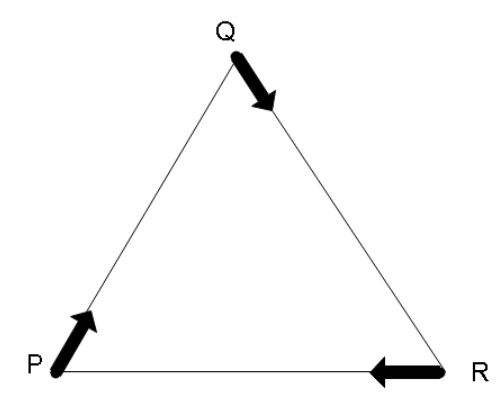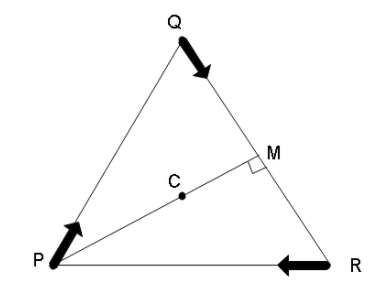Question
Question: Three-person P, Q, and R of the same mass travel with the same speed \(u\) along with an equilateral...
Three-person P, Q, and R of the same mass travel with the same speed u along with an equilateral triangle of side ′d′ such that each one faces the other always. After how much time will they meet each other?

Solution
In this solution, we will use the concepts of relative velocity. We will consider a particular person and determine the time it will take for the person to reach the centre of the triangle where all three people will meet.
Complete step by step answer:

In the diagram given to us, we can see that tall the three persons will have a velocity direction such that they will always be facing each other. This implies that while the initial direction of velocities of all the 3 people is in the direction of the sides of the triangle but eventually the velocity vector will shift as all the three people start moving inwards.
This implies that all three people slowly moving inward will eventually meet at the centroid of the triangle. Now, the distance between, say person P, and the centroid will be 2/3 times the length of the segment that joins P and the midpoint of the opposite side. SO, we can write
PC=32PM
Now, in an equilateral triangle, PM⊥QR, so using Pythagoras theorem, we can write
PM2+MR2=PR2
We can solve this for PM as
PM2=PR2−MR2
Substituting the value of PR=d and MR=d/2 (as M is the middle point), we get
PM2=d2−(2d)2
PM2=43d2
Which gives us
PM=23d
So, we can find PC=32PM as
PC=32×23d
⇒PC=d/3
So, the distance that has to be travelled by person P will be a=d/3 and the velocity vector will have a component corresponding to the difference of the angle formed by the two lines which will be equal to θ=60+(−30)=30∘. This is the angle between the velocity vectors of two persons P and Q.
So, we can write the effective component of velocity will be v=ucos30∘
Then the time taken by persons to meet will be:
t=ucos30∘d/3
∴t=3u2dseconds
Note: Here we should realize to use the concepts of relative velocity which will clarify our calculations very much. In doing so, we must be careful to take the distance to be travelled to be equal to the distance between one of the vertices of the triangle and the centroid. And while calculating the relative velocity, we must take the net component of the velocity taking into account the angle between the velocity vectors of two people.
